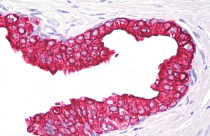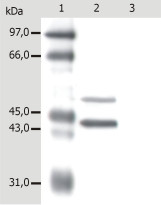ARG62980
anti-Cytokeratin 5 + 8 antibody [C-50]
anti-Cytokeratin 5 + 8 antibody [C-50] for ICC/IF,IHC-Formalin-fixed paraffin-embedded sections,Immunoprecipitation,Western blot and Human,Mouse,Rat,Bovine,Dog,Hamster,Pig,Sheep
Signaling Transduction antibody
Overview
| Product Description | Mouse Monoclonal antibody [C-50] recognizes Cytokeratin 5 + 8 |
|---|---|
| Tested Reactivity | Hu, Ms, Rat, Bov, Dog, Hm, Pig, Sheep |
| Species Does Not React With | Chk, Xenopus laevis |
| Tested Application | ICC/IF, IHC-P, IP, WB |
| Specificity | The antibody C-50 reacts with cytokeratin peptides 5 and 8 (58 and 53 kDa). Cytokeratins are members of intermediate filaments subfamily of intracellular proteins represented in epithelial tissues. |
| Host | Mouse |
| Clonality | Monoclonal |
| Clone | C-50 |
| Isotype | IgG1 |
| Target Name | Cytokeratin 5 + 8 |
| Immunogen | Cytoskeleton preparation from HeLa cells. |
| Conjugation | Un-conjugated |
| Alternate Names | DDD1; 58 kDa cytokeratin; Keratin, type II cytoskeletal 5; EBS2; Keratin-5; Cytokeratin-5; CK5; KRT5A; K5; CK-5; Type-II keratin Kb5; DDD |
Application Instructions
| Application Suggestion |
|
||||||||||
|---|---|---|---|---|---|---|---|---|---|---|---|
| Application Note | * The dilutions indicate recommended starting dilutions and the optimal dilutions or concentrations should be determined by the scientist. | ||||||||||
| Positive Control | IHC-P: Human prostate |
Properties
| Form | Liquid |
|---|---|
| Purification | Purified from ascites by protein-A affinity chromatography. |
| Purity | > 95% (by SDS-PAGE) |
| Buffer | PBS (pH 7.4) and 15 mM Sodium azide |
| Preservative | 15 mM Sodium azide |
| Concentration | 1 mg/ml |
| Storage Instruction | For continuous use, store undiluted antibody at 2-8°C for up to a week. For long-term storage, aliquot and store at -20°C or below. Storage in frost free freezers is not recommended. Avoid repeated freeze/thaw cycles. Suggest spin the vial prior to opening. The antibody solution should be gently mixed before use. |
| Note | For laboratory research only, not for drug, diagnostic or other use. |
Bioinformation
| Database Links | |
|---|---|
| Gene Symbol | KRT5 |
| Gene Full Name | keratin 5, type II |
| Background | Cytokeratin 5 is a member of the keratin gene family. The type II cytokeratins consist of basic or neutral proteins which are arranged in pairs of heterotypic keratin chains coexpressed during differentiation of simple and stratified epithelial tissues. This type II cytokeratin is specifically expressed in the basal layer of the epidermis with family member KRT14. Mutations in these genes have been associated with a complex of diseases termed epidermolysis bullosa simplex. The type II cytokeratins are clustered in a region of chromosome 12q12-q13. [provided by RefSeq, Jul 2008] |
| Research Area | Signaling Transduction antibody |
| Calculated MW | 62 kDa |
Images (2) Click the Picture to Zoom In
-
ARG62980 anti-Cytokeratin 5 + 8 antibody [C-50] IHC-P image
Immunohistochemistry: Paraffin-embedded Human prostate tissue stained with ARG62980 anti-Cytokeratin 5 + 8 antibody [C-50].
-
ARG62980 anti-Cytokeratin 5 + 8 antibody [C-50] WB image
Western blot: MCF-7 whole cell lysate stained with ARG62980 anti-Cytokeratin 5 + 8 antibody [C-50].
Lane 1: MW standard
Lane 2: Immunostaining with ARG62980
Lane 3: Immunostaining with Isotype Mouse IgG1 control.
Clone References









